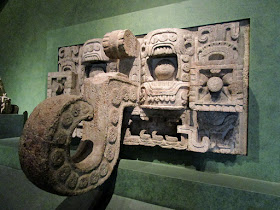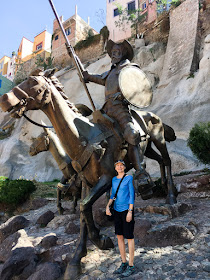
The park had benches with coyotes and was surrounded by colorful buildings.

Coyoacán dates back to 1521 during the Spanish conquest when it was the capital of New Spain. The Parroquia San Juan Bautista church was built in the 16th century.

The neighborhood had lots of bright colors. It was only in 1857 that Coyoacán was incorporated into Mexico City as a district.

In front of the Parroquia de San Sebastián church, a band was playing while costumed dancers danced.

Pete and Patty are in front of Casa Azul, Frida Kahlo’s home, which is now a museum. We had to wait in line to get in.

This bench was Frida’s as a child. Later she painted her name on it, along with watermelons and the year 1910. She was born in 1907, but she identified so strongly with Mexico and Mexican independence that she changed her birth year to coincide with Mexican Independence.

Severely injured at age 18 in a street car accident, Frida's back pain steadily worsened over time and she was often bed-ridden or forced to use a wheelchair when she painted. This is a photo of her studio. “I am not sick. I am broken. But I am happy to be alive as long as I can paint.”

We noticed many mermaids throughout the house and learned that Frida identified with the figures who don’t have legs. “Feet, what do I need you for when I have wings to fly?”

Throughout the house were Judas figures, which are traditionally burned on Easter. This one by Kristina is a Frida-Judas, complete with Frida’s necklace.

Frida was married to the painter Diego Rivera. When she died, Diego turned Casa Azul into the Frida Kahlo Museum.

Pete is on the stairwell overlooking the beautiful courtyard. We are happy we could visit Casa Azul.

Nearby was Casa Leon Trotsky, a museum about Leon Trotsky. Trotsky was granted permission to live in Mexico in 1937 through the efforts of Diego and Frida.

This is Trotsky’s study where he worked on many things, including an unflattering biography of Stalin. He was assassinated in his house in 1940. The house felt a bit like a bunker, with the windows blocked up to try to prevent an assassin from shooting Trotsky through the windows.

This tapestry is of a rain dance. Entitled Petition del Agua, it was created by Ezequiel and Clemencia José.

This painting Dios de Maiz, Corn Gods, by Rafael Lechuga shows the importance of corn to the Mexican people.

After seeing all those Mexican ingredients, we were hungry for lunch, so we made tacos. Ready to assemble are tortillas, pork, guacamole, pickled onions, jalapeños, nopales and chicharrones.

We went to the historic district in Mexico City. Kristina and Patty are in front of Palacio de Belles Artes.

Built primarily in the Art Nouveau and Art Deco styles, inside was grandiose with lots of natural light through the domes.

The murals inside were wonderful. During our trip the four of us reflected on and appreciated the five international trips we’ve made together: Japan in 2013, Quebec in 2014, Spain in 2015, South Korea in 2016 and now Mexico!

This is Man at the Crossroads by Diego Rivera. In 1934 (and shortly after a similar mural was removed from Rockefeller Center because of its communist themes), Rivera painted this mural in Palacio de Belles Artes.

Pete asked Bill to hold up the menu for a photo, and Bill hid behind it. We always have fun when Kristina’s folks travel with us!

We came upon a sculpture garden and had fun posing by our favorites, all by Alejandro Velasco. Pete is posing next to Niño Insecto. Behind Pete is Casa de los Azulejos, which is covered in blue and white tiles.

Patty is posing by Niña Cangrejo, Crab Girl. Patty is a Cancer, so perhaps this is why she chose the girl with crab claws instead of hands.
We went to lunch at El Cardenal. Kristina had incredibly tasty barbecued lamb with guacamole and nopales.

We also went to the Diego Rivera Mural Museum and fell in love with Dream of a Sunday Afternoon in Alameda Park. Each person in the mural is having their own dream.

This close up shows death as a Kukulcan skeleton with serpent flanked by a young Diego Rivera and Frida Kahlo.

Mexico City rebranded itself as CDMX about ten years ago. CDMX stands for Ciudad de México. Sin Poesía No Hay Ciudad is a collection of poetic phrases painted along the wall and is the work of Mexican poet and cultural promoter Armando Alanís Pulido.

A highlight of our time in CDMX was visiting National Anthropology museum. Patty and Kristina are next to Paraguas, Umbrella, by José Chávez Morado.

Native to Guanajuato, there is more of Chávez Morado's work later in this blog. This is a closer look at the umbrella handle.

We were very impressed with the Maya artworks, like this is Chaac rain god with his upturned nose asking for rain.

This is a chac mool, sacrificial altar, which was carved sometime between the 10th and 13th centuries.

A recreated tomb of King Pakal was incredible. King Pakal is wearing a jade mask and is covered in cinnabar.

We came to see the Diego Rivera murals, The History of Mexico, which were painted between 1929 and 1936.

Both Patty and Kristina look happy to see these incredible murals and to learn more about Mexican history.

All too soon it was time for Patty and Bill to fly back to San Diego. We went to the January 21st Women’s March sister rally in CDMX. Our estimate is there were at least 1,000 people at the march and about half were Americans. The march went around El Ángel near the US Embassy.

Kristina took a turn holding up the Women’s March sign. She is also holding her handmade sign, Mujeres Unidas, which means Women United. As we marched and chanted with the other protestors, we felt energized and supported by like minded people.

And this sign, “respect Mexico and Mexican immigrants” really resonated with us. We committed to ourselves to continue resisting Trump's racist, climate-change denial, conservative agenda and signed up with Two Hours a Week to take action daily.

Both of our Moms liked it when we wrote our blog in Spanish, so the next section is dedicated to Patty and to Pete's Mom, Csilla. (And if you'd prefer to read it in English, you can use Google Translate.)
Tomamos un autobús a Guanajuato. Aquí está Pete en la entrada de nuestro hotel, Mesón de los Poetas.

Todas las habitaciones tienen nombres de poetas, y nos quedamos en la habitación Juan Valle. Él nació en Guanajuato y era ciego.

Aquí Kristina está encima de las escaleras en el hotel. ¡Fue la primera vez que supimos que hay escaleras en todas partes de Guanajuato!

Subimos a ver la vista de la ciudad. La nombre Guanajuato es de lengua indígena y que significa lugar de muchas colinas. Es la verdad.

¡Los edificios tienen tantos colores que siempre vimos mirando! Y los edificios parecen aferrarse a las colinas.

Guanajuato se fundó en 1522 de los españoles. Encima de la colina que subimos hay una escultura grande, se llama el Pípula. El Pípula es el símbolo de la independencia de México.
Aprendimos que en 1821, el Pípula puso una piedra en la espalda y quemó la puerta de la Alhóndiga, una acción que comenzó la guerra contra los españoles.

Visitamos la Alhóndiga y vimos que el exterior tiene huecos de la guerra. En 1820, el edificio se usó para conservar grano y cereales.
La Alhóndiga es un museo ahora, y tiene murales con El Pípula.

Kristina está al lado de un coche de mina. Durante 250 años, las minas de Guanajuato produjeron el 30% de la plata en el mundo. Los españoles eran ricos cuando la gente de Guanajuato era muy pobre, así que la gente se rebeló y comenzó una guerra que se extendió a todo México durante once años.
Este edificio es la Universidad de Guanajuato.

Los edificios tienen letreros encantadores con el nombre de la casa o información sobre el edificio.


Cerca de nuestro hotel está la Plaza de la Paz con la Basílica Colegiata de Nuestra Señora de Guanajuato que se construyó entre 1671 y 1696.

Nos gustó quedarnos en el centro histórico de Guanajuato. Muy cerca de nuestro hotel está el Teatro Juárez.

Chávez Morado era parte del movimiento arte de muralistas mexicanas pero también él hizo grabados. Este grabado se llama Obreros de Ciudad Universitaria, y muestra un coche de mina plata.

Hay muchos túneles en Guanajuato. Primero pensamos que los túneles eran de las minas. Pero en verdad, eran de la sistema a controlarse la lluvia y pararse deluges.

Tenemos sorpresa que Guanajuato es enamorado de Cervantes y Don Quijote. Kristina está al lado de un gran estatua de Don Quijote.

Comimos muy bien en Guanajuato. La comida más interesante que comimos fue chapulines. Con guacamole, el sabor era muy rico.

Buscamos una gelateria y comimos helados cada día. Nuestros favoritos eran cardamomo y ciruela con chocolate. Aquí Kristina tiene caramelo y chocolate.


























































